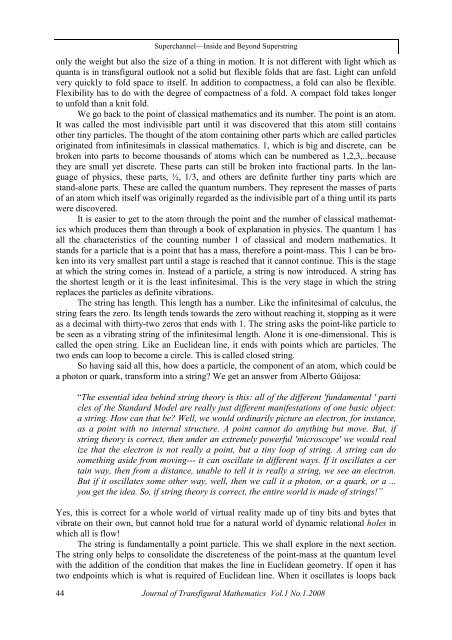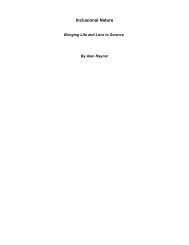JTfM Vol 1 No 1 2008 - ONLINE EDITION - Inclusionality Research
JTfM Vol 1 No 1 2008 - ONLINE EDITION - Inclusionality Research
JTfM Vol 1 No 1 2008 - ONLINE EDITION - Inclusionality Research
Create successful ePaper yourself
Turn your PDF publications into a flip-book with our unique Google optimized e-Paper software.
Superchannel—Inside and Beyond Superstring<br />
only the weight but also the size of a thing in motion. It is not different with light which as<br />
quanta is in transfigural outlook not a solid but flexible folds that are fast. Light can unfold<br />
very quickly to fold space to itself. In addition to compactness, a fold can also be flexible.<br />
Flexibility has to do with the degree of compactness of a fold. A compact fold takes longer<br />
to unfold than a knit fold.<br />
We go back to the point of classical mathematics and its number. The point is an atom.<br />
It was called the most indivisible part until it was discovered that this atom still contains<br />
other tiny particles. The thought of the atom containing other parts which are called particles<br />
originated from infinitesimals in classical mathematics. 1, which is big and discrete, can be<br />
broken into parts to become thousands of atoms which can be numbered as 1,2,3,..because<br />
they are small yet discrete. These parts can still be broken into fractional parts. In the language<br />
of physics, these parts, ½, 1/3, and others are definite further tiny parts which are<br />
stand-alone parts. These are called the quantum numbers. They represent the masses of parts<br />
of an atom which itself was originally regarded as the indivisible part of a thing until its parts<br />
were discovered.<br />
It is easier to get to the atom through the point and the number of classical mathematics<br />
which produces them than through a book of explanation in physics. The quantum 1 has<br />
all the characteristics of the counting number 1 of classical and modern mathematics. It<br />
stands for a particle that is a point that has a mass, therefore a point-mass. This 1 can be broken<br />
into its very smallest part until a stage is reached that it cannot continue. This is the stage<br />
at which the string comes in. Instead of a particle, a string is now introduced. A string has<br />
the shortest length or it is the least infinitesimal. This is the very stage in which the string<br />
replaces the particles as definite vibrations.<br />
The string has length. This length has a number. Like the infinitesimal of calculus, the<br />
string fears the zero. Its length tends towards the zero without reaching it, stopping as it were<br />
as a decimal with thirty-two zeros that ends with 1. The string asks the point-like particle to<br />
be seen as a vibrating string of the infinitesimal length. Alone it is one-dimensional. This is<br />
called the open string. Like an Euclidean line, it ends with points which are particles. The<br />
two ends can loop to become a circle. This is called closed string.<br />
So having said all this, how does a particle, the component of an atom, which could be<br />
a photon or quark, transform into a string? We get an answer from Alberto Güijosa:<br />
“The essential idea behind string theory is this: all of the different 'fundamental ' parti<br />
cles of the Standard Model are really just different manifestations of one basic object:<br />
a string. How can that be? Well, we would ordinarily picture an electron, for instance,<br />
as a point with no internal structure. A point cannot do anything but move. But, if<br />
string theory is correct, then under an extremely powerful 'microscope' we would real<br />
ize that the electron is not really a point, but a tiny loop of string. A string can do<br />
something aside from moving--- it can oscillate in different ways. If it oscillates a cer<br />
tain way, then from a distance, unable to tell it is really a string, we see an electron.<br />
But if it oscillates some other way, well, then we call it a photon, or a quark, or a ...<br />
you get the idea. So, if string theory is correct, the entire world is made of strings!”<br />
Yes, this is correct for a whole world of virtual reality made up of tiny bits and bytes that<br />
vibrate on their own, but cannot hold true for a natural world of dynamic relational holes in<br />
which all is flow!<br />
The string is fundamentally a point particle. This we shall explore in the next section.<br />
The string only helps to consolidate the discreteness of the point-mass at the quantum level<br />
with the addition of the condition that makes the line in Euclidean geometry. If open it has<br />
two endpoints which is what is required of Euclidean line. When it oscillates is loops back<br />
44<br />
Journal of Transfigural Mathematics <strong>Vol</strong>.1 <strong>No</strong>.1.<strong>2008</strong>




